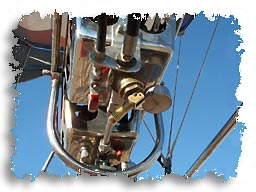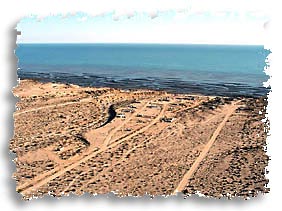For
most people,
the word balloonist
conjures up someone who twists
air-filled bladders into toy animals. But Ken Eskeback
doesn't do that. His balloon can't be filled with one
or two stout exhalations of the lungs. In fact, it takes
77,500 cubic feet of air to inflate it. And then the fun
begins...
On my way into town one morning I noticed a white truck
parked on the side of the highway with the words Balloon
Rides painted on the
door panel. I pulled over and found Belinda Jackson holding
a walkie-talkie and looking into the sky. I followed her
eyes and saw a colorful hot air balloon hovering over
Pete's Camp.
"Do you want a ride?" she asked.
 I
nodded mutely and she spoke into the walkie-talkie.
The
pilot's voice crackled back.
A few minutes later, the money talk out of the way, I
got into my car and followed Belinda to a clearing at
Campo Ocotillos where the pilot agreed to meet us. I
nodded mutely and she spoke into the walkie-talkie.
The
pilot's voice crackled back.
A few minutes later, the money talk out of the way, I
got into my car and followed Belinda to a clearing at
Campo Ocotillos where the pilot agreed to meet us.
Ballooning is a profoundly quiet event, until you want
to ascend. Once I had climbed safely into the basket and
introductions were made, Ken Eskeback, the pilot, decided
to show me what an emergency climb was like.
"Pretend we're about to hit some power lines,"
he said with a grin. His hands went up to two levers on
the twin burners overhead. Then a sound like a T-Rex with
a megaphone shook the sky. Dogs began barking in the camp.
After a brief pause the basket lurched off the ground
and we were airborne, rising rapidly.
 "There's
at least a six second delay from when you blast the burners
until the balloon responds," he explained. "The
same when you spill air." He pulled on a rope and
the balloon buckled on one side. About six seconds later
we began a slow descent. "There's
at least a six second delay from when you blast the burners
until the balloon responds," he explained. "The
same when you spill air." He pulled on a rope and
the balloon buckled on one side. About six seconds later
we began a slow descent.
With a long howl from the burners, Ken sent us into the
air again. The altimeter read about a thousand feet when
we leveled out. A barely discernible breeze was carrying
us over the highway toward the ejido. Below, Belinda followed
the backroads in the "chase truck" and
kept ahead of us, maintaining radio contact.
The balloon threw its shadow over the ejido. A few Mexican
children, excited by the strange spectacle, lept on their
bicycles and followed the shadow. Ken decided to set down
near a hill of red dirt so we could board a few of the
kids. With a young brother and sister aboard, wide-eyed
and Cheshire-grinned, we roared back into the sky then
quietly floated above the youngsters' home. They were
ecstatic.
Ken managed to set the basket back down near the bicycles
and the chase car pulled up. Several ejido members gathered
at the landing site and Ken enlisted their help to deflate
and fold the giant fabric of the balloon. A few others
hefted the basket onto the back of the chase truck.
|
.
Ken's balloon
is considered 'smallish' for its family. At 77,500 cubic
feet, with a basket that can hold three plus the pilot
(if you're friendly), the Eske II, as he calls it, seems
more than adequate for the job.
Like airplanes,
ballooning is a technical field. Obtaining a Balloon
Rating requires a significant amount of training. Someone
who wants their Commerical Pilot's Certification in
the lighter-than-air category must have:
-
20
hours in a balloon
- 10 flights in a balloon
- 2 flights in balloons as the
pilot in command
- 10 hours of flight training
that includes at least 10 training flights with an authorized
instructor in balloons
In addition, knowledge of aeronautical charts and the
magnetic compass for free balloon navigation as well as
recognition of weather conditions are needed tools for
the private as well as commerical balloon pilot.
Ken has 520 hours logged in balloons. At one time he
ran a skydiving center in Toledo, Washington.
While gliding over the desert, Ken took the time to
show me some of the technical aspects of ballooning
and explain a few things. His balloon carries three
10 gal. propane bottles, which can last between one
and a half to two hours of flight time. The basket of
the Eske II was equipped with an altimeter, a bariometer,
which mesured the rate of ascent, an envelope temperature
gauge and an ambient temperature gauge. The balloon
itself, fabricated in 1991, was made of rip-stop nylon.
Ken's flight plans always depend upon weather conditions,
naturally. He often releases a helium-filled piball (short
for 'pilot's balloon') whose actions inform him about
flying conditions and whether the location is suitable
for liftoff.
Once a site is chosen, the balloon envelope is laid out
on the ground and the crew begins inflating it, using
a powerful fan at the base of the envelope. When there
is enough air in the balloon, the burners are lit and
fired into the envelope mouth. This heats the air, building
pressure until the balloon inflates all the way and starts
to lift off the ground. There's always a crowd of curious
people on hand during the process and Ken often uses them
to help keep the balloon on the ground until he is ready
to lift off.
 Reaching
the right altitude is a tricky matter for a balloon pilot
because there is anywhere from a 6-30 second delay between
blasting the burners and the balloon's reaction. I watched
Ken operate the controls just a little bit before he wanted
to rise, and shut them off a little bit before he wanted
to stop rising. He told me inexperienced pilots often
overshot, rising too high before leveling off. Properly
controlled flight only comes after many hours of piloting
a balloon. Reaching
the right altitude is a tricky matter for a balloon pilot
because there is anywhere from a 6-30 second delay between
blasting the burners and the balloon's reaction. I watched
Ken operate the controls just a little bit before he wanted
to rise, and shut them off a little bit before he wanted
to stop rising. He told me inexperienced pilots often
overshot, rising too high before leveling off. Properly
controlled flight only comes after many hours of piloting
a balloon.
| If you are interested in learning more about
lighter-than-air devices, click
HERE
to visit the 'How Stuff Works' site, where there is
a nice introduction to ballooning. |
|